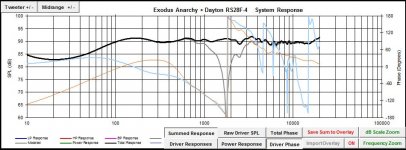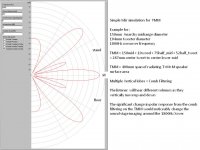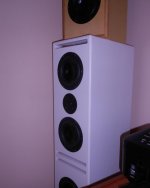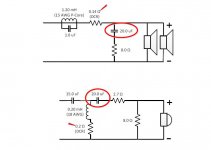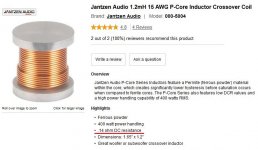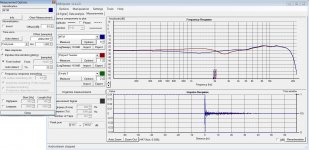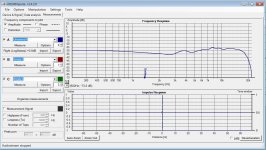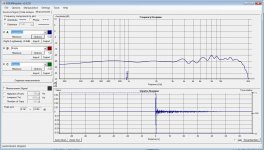Originally, I built this Anarchy TMM system using 2 8-ohm woofers wired in parallel, mated with a Dayton RS28F-4 tweeter, as an active system. The active crossover was done with the Behringer DCX2496, but I also liked having the flexibility of using these as a passive system, so I modeled a crossover in PCD. The actual measurements came out to exactly the same as the sim, so I was quite happy with the results. After running it through a variety of music, the Renditions are still my favorite speakers. Bass is insane, and the RS28F tweeter proves to be one of the best values out there. Here are some data on the build:
- Crossover frequency: 1,800Hz
- Box Volume: 1.0 cu.ft, tuned at 36Hz
- 2nd order electrical on woofers, 3rd on tweeters
- 9 total components, so inexpensive parts overall
Hong
- Crossover frequency: 1,800Hz
- Box Volume: 1.0 cu.ft, tuned at 36Hz
- 2nd order electrical on woofers, 3rd on tweeters
- 9 total components, so inexpensive parts overall
Hong
Attachments
-
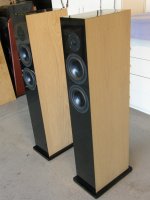 P4280605.JPG412.7 KB · Views: 1,669
P4280605.JPG412.7 KB · Views: 1,669 -
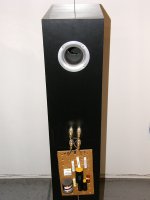 P5060608.JPG376.9 KB · Views: 1,529
P5060608.JPG376.9 KB · Views: 1,529 -
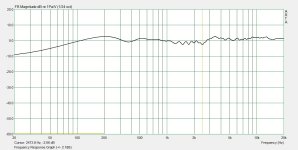 RENDITIONS FR W.jpg143.4 KB · Views: 1,453
RENDITIONS FR W.jpg143.4 KB · Views: 1,453 -
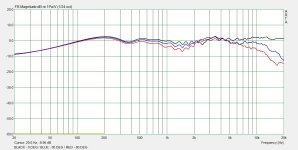 RENDITIONS 0-30-60 W.jpg160.1 KB · Views: 1,406
RENDITIONS 0-30-60 W.jpg160.1 KB · Views: 1,406 -
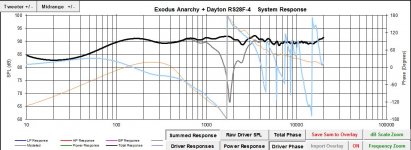 RENDITIONS - Phase.JPG108.3 KB · Views: 1,391
RENDITIONS - Phase.JPG108.3 KB · Views: 1,391 -
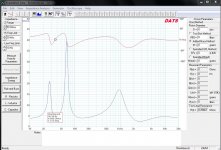 Impedance Sweep - Renditions.JPG137.2 KB · Views: 311
Impedance Sweep - Renditions.JPG137.2 KB · Views: 311 -
RENDITIONS DIMENSIONS.pdf44.1 KB · Views: 184
-
RENDITIONS X-OVER 4-27-15.pdf30.6 KB · Views: 270
Do you hear any comb filtering?
When I run simple polar simulations like Xdir for a TMM topology speaker with 6" midranges I usually observe comb filtering issues, which moves the design to a TM-WW 3-way. I like the idea of adding a real 6" midrange like the SB17NRC35 (Mms=11g, 92db sensitivity) and using the two Anarchys (Mms: 30g, 84.5db sensitivity) as woofers in a separate box volume with a separate Xover. The midrange crossover does become more complicated.
One example for:
150mm Anarchy midrange diameter
104mm tweeter diameter
TMM = 150mid + 10wood + 75half_mid + 52half_tweet = 287mm center tweet to center second mid
TMM = 400mm span of radiating T+M+M speaker surface area
You describe a TMM topology, with both M electrically connected in parallel and using the same passive Xover. Around the crossover frequency all three speakers TMM are vibrating and generating air pressure waves. Think of the total TMM surface area as a collection of vibrating points spanning ~400mm from top-of-T to bottom-of-M, which arrive at different angles/times to the listener's ears. A 1800Hz wavelength is 190mm (7.5") long. At frequencies around the crossover the air pressure from one vibrating point arriving at the listener from speaker angleX can be inverse to the air pressure from a second vibrating point 190mm away on the 400mm long surface arriving at the listener from speaker angleY, and interact(X*Y) to cause a lower pressure(SPL) at the ear. Around 1800Hz, a seated listener can hear a different SPL, from a standing listener, from a listener laying on the floor. At frequencies around the crossover... lobing..... comb filtering... describe this change in vertical SPL. The significant change in polar response from the comb filtering on the TMM would noticably change the sound stage imaging around the 1800Hz Xover.
When I run simple polar simulations like Xdir for a TMM topology speaker with 6" midranges I usually observe comb filtering issues, which moves the design to a TM-WW 3-way. I like the idea of adding a real 6" midrange like the SB17NRC35 (Mms=11g, 92db sensitivity) and using the two Anarchys (Mms: 30g, 84.5db sensitivity) as woofers in a separate box volume with a separate Xover. The midrange crossover does become more complicated.
One example for:
150mm Anarchy midrange diameter
104mm tweeter diameter
TMM = 150mid + 10wood + 75half_mid + 52half_tweet = 287mm center tweet to center second mid
TMM = 400mm span of radiating T+M+M speaker surface area
You describe a TMM topology, with both M electrically connected in parallel and using the same passive Xover. Around the crossover frequency all three speakers TMM are vibrating and generating air pressure waves. Think of the total TMM surface area as a collection of vibrating points spanning ~400mm from top-of-T to bottom-of-M, which arrive at different angles/times to the listener's ears. A 1800Hz wavelength is 190mm (7.5") long. At frequencies around the crossover the air pressure from one vibrating point arriving at the listener from speaker angleX can be inverse to the air pressure from a second vibrating point 190mm away on the 400mm long surface arriving at the listener from speaker angleY, and interact(X*Y) to cause a lower pressure(SPL) at the ear. Around 1800Hz, a seated listener can hear a different SPL, from a standing listener, from a listener laying on the floor. At frequencies around the crossover... lobing..... comb filtering... describe this change in vertical SPL. The significant change in polar response from the comb filtering on the TMM would noticably change the sound stage imaging around the 1800Hz Xover.
Attachments
I was asked if the crossover worked for a MTM configuration, so I modeled one as well. Thanks for looking.
Hong
Ok Hong! Way ahead of me, no xo here, using these for speaker stands right now.
There are a couple of the Dayton 28 tweeters, is this design for the RS28F-4?
Attachments
Originally, I built this Anarchy TMM system using 2 8-ohm woofers wired in parallel, mated with a Dayton RS28F-4 tweeter
Have the parts to mock these up, except the 0.14 and 0.2 ohm resistors.
They seem really small for a xo circuit - am I missing something
Hi,
The small resistors are the DCR of the coils.
rgds, sreten.
For simming the 1uF is not connected correctly.
Last edited:
I did this design for many reasons.
1. The tweeter is at ear level when I'm sitting at the listening position, so the height of the tower ended up being reasonable and the design pleasing to the eye.
2. Comb filtering being a vertical phenomenon, my listening distance 20 feet away, I rarely listen to music lying on the floor or standing for hours, so this a non-issue for me. In addition, I use a DEQ2496 to correct minor room modes, so the end result is a virtually flat response overall.
Thanks.
1. The tweeter is at ear level when I'm sitting at the listening position, so the height of the tower ended up being reasonable and the design pleasing to the eye.
2. Comb filtering being a vertical phenomenon, my listening distance 20 feet away, I rarely listen to music lying on the floor or standing for hours, so this a non-issue for me. In addition, I use a DEQ2496 to correct minor room modes, so the end result is a virtually flat response overall.
Thanks.
Do you hear any comb filtering?
When I run simple polar simulations like Xdir for a TMM topology speaker with 6" midranges I usually observe comb filtering issues, which moves the design to a TM-WW 3-way. I like the idea of adding a real 6" midrange like the SB17NRC35 (Mms=11g, 92db sensitivity) and using the two Anarchys (Mms: 30g, 84.5db sensitivity) as woofers in a separate box volume with a separate Xover. The midrange crossover does become more complicated.
One example for:
150mm Anarchy midrange diameter
104mm tweeter diameter
TMM = 150mid + 10wood + 75half_mid + 52half_tweet = 287mm center tweet to center second mid
TMM = 400mm span of radiating T+M+M speaker surface area
You describe a TMM topology, with both M electrically connected in parallel and using the same passive Xover. Around the crossover frequency all three speakers TMM are vibrating and generating air pressure waves. Think of the total TMM surface area as a collection of vibrating points spanning ~400mm from top-of-T to bottom-of-M, which arrive at different angles/times to the listener's ears. A 1800Hz wavelength is 190mm (7.5") long. At frequencies around the crossover the air pressure from one vibrating point arriving at the listener from speaker angleX can be inverse to the air pressure from a second vibrating point 190mm away on the 400mm long surface arriving at the listener from speaker angleY, and interact(X*Y) to cause a lower pressure(SPL) at the ear. Around 1800Hz, a seated listener can hear a different SPL, from a standing listener, from a listener laying on the floor. At frequencies around the crossover... lobing..... comb filtering... describe this change in vertical SPL. The significant change in polar response from the comb filtering on the TMM would noticably change the sound stage imaging around the 1800Hz Xover.
For simming the 1uF is not connected correctly.
sreten, the 1uF cap is part of the parallel RLC notch filter, in series before the crossover, so I don't understand your comment here.
Hong
sreten, the 1uF cap is part of the parallel RLC notch filter, in series before the crossover, so I don't understand your comment here.
Hong
Hi,
It should connect across the coil and its DCR, it's a minor point.
rgds, sreten.
Last edited:
Thank you Scottmoose and pardon the interruption folks.
Have the parts to mock these up, except the 0.14 and 0.2 ohm resistors.
They seem really small for a xo circuit - am I missing something
Doug, this is the resistance that comes with the inductor, so picking a different gauge or type of inductor may result in a change to the crossover frequency response, phase and impedance. The difference may be insignificant overall, my values are a just starting point, so you can experiment and go from there.
Hong
Attachments
Doug, this is the resistance that comes with the inductor
Hong
Yes, all coming back to me now.
Here's one done, sounds nice, powerful/efficient.
(the red line is tweeter leads reversed)
[had one 1.2 14 gauge air core on hand]
Checking now to see if woofers are in series
Attachments
Last edited:
Hong,
We are having a blast with the new xo, and again only had enough parts for one. The ploy was to mock up and measure before ordering parts.
It's connected to a small Luxman R-114 receiver - hard to believe the bass pouring out from a small amp and small 6.5" cones
This box is slightly bigger, 1.3cf (net) and double 9" x 3/4" x 18" ports (243 square inches). The material is 16" shelving board from local lumber yard, although as bad as that sounds, it is a nice solid grade of MDF. The seams didn't move much in the last couple of years, which is pretty common with MDF. Will rebuild with BB someday. The tuning is 40hz (I think, need to recheck).
We are having a blast with the new xo, and again only had enough parts for one. The ploy was to mock up and measure before ordering parts.
It's connected to a small Luxman R-114 receiver - hard to believe the bass pouring out from a small amp and small 6.5" cones

This box is slightly bigger, 1.3cf (net) and double 9" x 3/4" x 18" ports (243 square inches). The material is 16" shelving board from local lumber yard, although as bad as that sounds, it is a nice solid grade of MDF. The seams didn't move much in the last couple of years, which is pretty common with MDF. Will rebuild with BB someday. The tuning is 40hz (I think, need to recheck).
Last edited:
Doug, just run an impedance sweep. My box was tuned at 36Hz, so yours may be lower due to the larger size.
Hong
Hong
Hong,
We are having a blast with the new xo, and again only had enough parts for one. The ploy was to mock up and measure before ordering parts.
It's connected to a small Luxman R-114 receiver - hard to believe the bass pouring out from a small amp and small 6.5" cones
This box is slightly bigger, 1.3cf (net) and double 9" x 3/4" x 18" ports (243 square inches). The material is 16" shelving board from local lumber yard, although as bad as that sounds, it is a nice solid grade of MDF. The seams didn't move much in the last couple of years, which is pretty common with MDF. Will rebuild with BB someday. The tuning is 40hz (I think, need to recheck).
The problem was the generator died and had to borrow one from a buddy.
So my 10.5" wide box is .3 ft3 larger and tuned to 35hz (slightly lower).
I'm curious if the wider width will affect the baffle step diffraction, more or less bass. Not that I'm complaining, the bass is terrific.
Any thoughts about adding a MM sub-bass? This woofer would be a perfect candidate with the extra long throw.
Check out this crazy amp - I don't think it weighs as much as the piece of wood that is cut-out to install it and two of them cost less than a active dbx xo! I have one in use now, it works fine.
Yung SD100 100W Class D Subwoofer Plate Amplifier Module No Boost
So my 10.5" wide box is .3 ft3 larger and tuned to 35hz (slightly lower).
I'm curious if the wider width will affect the baffle step diffraction, more or less bass. Not that I'm complaining, the bass is terrific.
Any thoughts about adding a MM sub-bass? This woofer would be a perfect candidate with the extra long throw.
Check out this crazy amp - I don't think it weighs as much as the piece of wood that is cut-out to install it and two of them cost less than a active dbx xo! I have one in use now, it works fine.
Yung SD100 100W Class D Subwoofer Plate Amplifier Module No Boost
Doug, in regards to the MM, please be aware that this is a parallel crossover. The upper woofers' impedance is 4 ohms, and the bottom ones, if wired in parallel, will also be 4 ohms. You can only add a MM if all woofers are of the 4-ohm variety, wired in series, then in parallel, to come to a net of 4 ohms.
Hong
Hong
- Home
- Loudspeakers
- Multi-Way
- The Renditions - An Anarchy TMM/MTM Build
